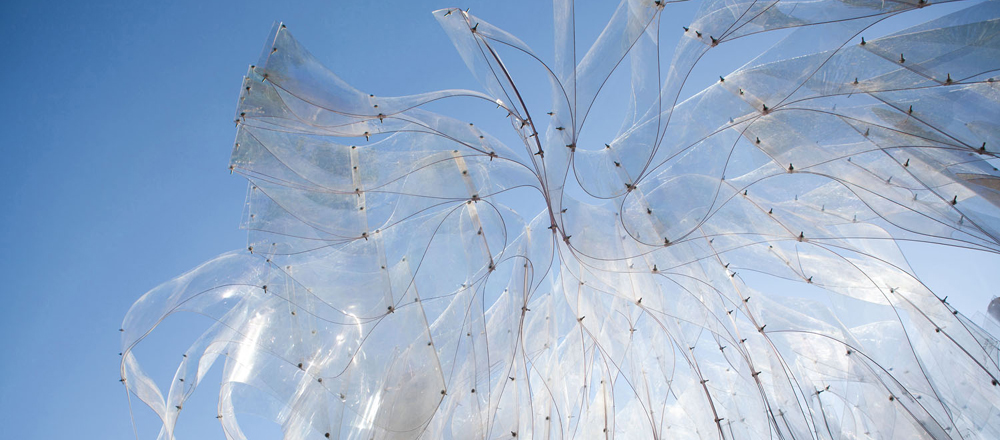Anisotropic Geometry: Pavilion Ban

'Ban' is the Chinese word for flower petals. The pavilion designed by Orproject for Beijing Design Week 2012 was constructed similar to the way that the stability of a flower is created by its bent petals. The shapes and volumes of the installation are formed by a multitude of bent layers of transparent polymer sheets that stabilise each other.
Architects: Orproject, London
Location: Peking, China
Architects: Orproject, London
Location: Peking, China
"A flat sheet of a flexible or thin material tends to be soft and easily deformable. However as soon as the sheet is bent into a curve and held in this position, it becomes very strong in its vertical direction,” explains Orproject partner Rajat Sodhi. "This principle can be seen in many flowers, where the petals are bent so that they can form the shape of the corolla, and this principle has also been used for the construction of Ban." Orproject designed the pavilion using a system of columns, arches and vaults, which are all based on anisotropic geometries.
The layout of Ban is organised around four centres. The thin PETG sheets were all CNC-milled and marked with identification numbers, describing the position of each element in the pavilion and the relationship with the neighbouring pieces. As soon as the cold-bent sheets are fixed with nuts and bolts, the structure begins to act as a self-supporting system.
The arrangement of polymer sheets forms a field of curved edges. These lines appear to continue across the different sheets and create a network of flowing curves. The shape of the lines develops iteratively from each sheet to the one behind it. The resulting array of edges and lines directs the viewer's eye and visually unites the individual sheets to a clearly defined overall shape that is both transparent and translucent.
Geometries similar to those in the Ban installation, were used by the experimental architects at Orproject in earlier projects, such as Anisotropia, constructed for the design of the Busan Opera House. Anisotropia is based on a composition for piano. A unit composed of two curved sheets is stringed together and modulated, similar to the composition in which a basic twelve tone row is transformed continuously. The hanging lamellas become the prototypes for a wall system that can control the light, view and shading properties.
Ban is a small scale test of the structural possibilities of such anisotropic systems, which Orproject could use in future projects. "We may be testing a new material or a new construction system for its architectural potential and application for large scale buildings," explains the architect and Orproject partner Christoph Klemmt.
Design team: Christoph Klemmt, Sambit Samant, Rajat Sodhi
Project managers: Christine Wu, Shuai Yang
Project team: Kevin Wang, Marian Ma, Qiuwen Shi
Completion: October 2012
Sponsors: SK Chemicals, Penghao Theatre www.orproject.com
Design team: Christoph Klemmt, Sambit Samant, Rajat Sodhi
Project managers: Christine Wu, Shuai Yang
Project team: Kevin Wang, Marian Ma, Qiuwen Shi
Completion: October 2012
Sponsors: SK Chemicals, Penghao Theatre www.orproject.com
